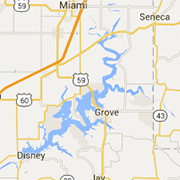GRDA, USFWS share information on Northern Long-Eared Bat
A unique species of bat, the Northern long-eared bat, which makes its home around Grand River Dam Authority (GRDA) lakes is listed as a threatened species (a species likely to become endangered in the future) under the Endangered Species Act. In an effort to help protect these bats and their habitat, the Grand River Dam Authority and the United States Fish & Wildlife Service (USFWS) are working together to educate the public about these special lake area residents.
The northern long-eared bat (Myotis septentrionalis) was added to the threatened list primarily due to a disease called white-nose syndrome (WNS), which is drastically impacting and killing hibernating bats. WNS has killed more than 6 million bats in eastern North America, and the fungus that causes the disease was recently found in caves in Northeast Oklahoma.
The northern long-eared bat is a medium-sized bat that can be distinguished by its long ears, especially when compared to most other bats found in the area. The range of this species covers 23 counties in Oklahoma, including all of Grand Lake and Lake Hudson. Northern long-eared bats are very beneficial to lake ecosystems. Each bat can consume up to 3,000 insects per night, including mosquitoes and crop pests. In fact, scientists now believe that bats, in general, save us more than $3 billion dollars per year in pest control by simply eating insects.
During the summer months, the bats roost by themselves or as part of colonies underneath the bark or in the cavities and crevices of both live and dead trees. These trees provide the bats with a thermally stable environment and protection from the weather and predators. They also rear pups or “baby bats” during this roosting time, making it crucial for these trees to be undisturbed.
To help preserve that habitat, GRDA and the USFWS offer the following tips:
- Don’t cut trees greater than 3 inches in diameter at breast height (dbh) between April 1 and July 31, unless the tree poses a hazard to property.
- For hazardous trees, closely inspect the tree for roosting bats prior to removal.
- When safety is not a concern, leave dead or dying trees on your property.
- As always, GRDA recommends that you DON’T CUT, DON’T DIG, and DON’T BUILD below the GRDA taking line, or within the U. S. Army Corps of Engineers (USACE) flowage easement until you have contacted the GRDA Ecosystems and Education Center at (918) 782-4726 or lakepermits@grda.com, and USACE at (918) 669-7253.
If you are interested in learning more about the northern long-eared bat visit: https://www.fws.gov/Midwest/endangered/mammals/nleb/nlebFactSheet.html
If you are interested in learning more about white-nose syndrome visit:
https: www.whitenosesyndrome.org
For more information, you can also contact the GRDA Ecosystems Management Department at (918) 256-0723.
# # #









